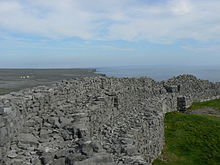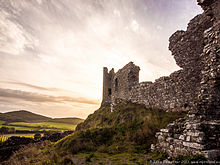A dun is an ancient or medieval fort. In Ireland and Britain it is mainly a kind of hillfort and also a kind of Atlantic roundhouse.



Etymology
The term comes from Irish dún or Scottish Gaelic dùn (meaning "fort"), and is cognate with Old Welsh din (whence Welsh dinas "city" comes).
In certain instances, place-names containing Dun- or similar in Northern England and Southern Scotland, may be derived from a Brittonic cognate of the Welsh form din.[1] In this region, substitution of the Brittonic form by the Gaelic equivalent may have been widespread in toponyms.[1]
Details
In some areas duns were built on any suitable crag or hillock, particularly south of the Firth of Clyde and the Firth of Forth. There are many duns on the west coast of Ireland and they feature in Irish mythology. For example, the tale of the Táin Bó Flidhais features Dún Chiortáin and Dún Chaocháin.
Duns seem to have arrived with the Celts in about the 7th century BC. Early duns had near vertical ramparts made of stone and timber. There were two walls, an inner wall and the outside one. Vitrified forts are the remains of duns that have been set on fire and where stones have been partly melted. Use of duns continued in some parts into the Middle Ages.
Duns are similar to brochs, but are smaller and probably would not have been capable of supporting a very tall structure. Good examples of this kind of dun can be found in the Outer Hebrides of Scotland, on artificial islands in small lakes.
This article uses material from the Wikipedia article
Metasyntactic variable, which is released under the
Creative Commons
Attribution-ShareAlike 3.0 Unported License.